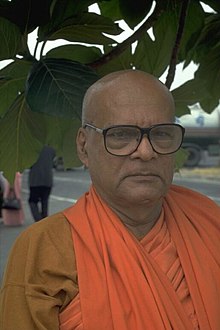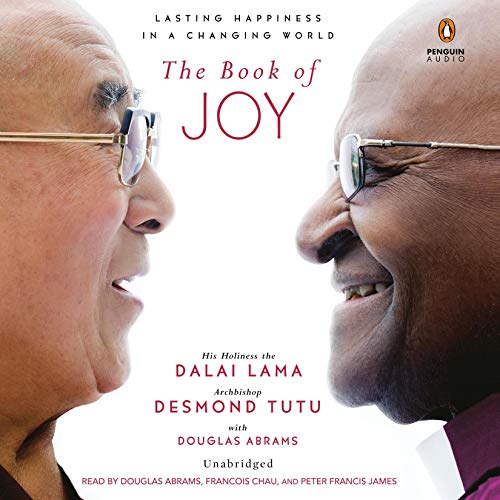K. Sri Dhammananda
From Wikipedia, the free encyclopedia
K. Sri Dhammananda

Title First Buddhist Chief High Priest of Malaysia (1963-2006)
Personal
Born
Martin Garmage
18 March 1919
Matara, Sri Lanka
Died 31 August 2006 (aged 87)
Subang Jaya Medical Centre, Subang Jaya, Malaysia
Religion Buddhism
School Theravada
Education Banaras Hindu University
Senior posting
Based in Kuala Lumpur, Malaysia
Successor Kirinde Sri Dhammaratana
K. Sri Dhammananda (born Martin Gamage, 18 March 1919 – 31 August 2006) was a Sri Lankan Buddhist monk and scholar.
Contents
1Early life
2Education and training
3Malaysia
4Buddhist Missionary Society
5Publications and doctorates
6Death
7References
8External links
Early life[edit]
Born in the village of Kirinde in Matara, Sri Lanka, Dhammananda spent most of his life and career in Malaysia. He was ordained as a novice monk (samanera) at the age of 12 and was fully ordained in 1940. After arriving in Malaya, now part of Malaysia, in 1952, Dhammananda established himself as the foremost[citation needed] Theravada Buddhist monk in Malaysia and Singapore.
Education and training[edit]
Venerable Dhammananda enrolled at the Sri Dhammarama Pirivena, Ratmalana in 1935, and then at the Vidyawardhana Buddhist Institute, Colombo, 1937 for a more detailed study of the Buddha's teaching. His mentor was the Venerable Kotawila Deepananda Nayaka Thera. Upon completion of his studies in 1938, he entered Vidyalankara Pirivena, in Peliyagoda, Kelaniya, a prestigious Buddhist college that has since been upgraded into a university.
For the next seven years, Venerable Dhammananda attended a diploma programme at the Vidyalanka Pirivena where he studied Sanskrit, the Pali Tipitaka and Buddhist philosophy, besides other secular subjects. His principal tutor at the Institute was the Venerable Lunupokune Sri Dhammananda, an eminent scholar monk. At age 26, he successfully graduated with a diploma in Linguistics and Pali Tipitaka.
His seven years of intensive learning and training in monastic discipline from 1939 to 1945 at the Vidyalanka Pirivena provided him the relevant knowledge and skills in missionary techniques. He was able to use his training to assist the Buddhists in Ceylon, especially those who were English educated and had been prime targets of Christian proselytisation, in understanding the more intellectual aspects of the Buddha's teachings. In 1945 Venerable Dhammananda furthered his tertiary education at the Benares Hindu University in India where he was awarded a scholarship. At the university, he read Sanskrit, Hindi and Indian Philosophy.
His contemporaries at the University included Venerable P. Panananda Nayaka Thera of Colombo, Venerable Dr. H. Saddhatissa Maha Thera (who later became head of the London Buddhist Vihara), Venerable Dr. U. Dhammaratana and the late Venerable Dr. Amritananda Thera, former head of the Sangha of Nepal. Venerable Dhammananda studied four years at the university graduating with a Master of Arts degree in Indian Philosophy in 1949. Among the many well-known professors who taught him was the late Dr. S. Radhakrishnan, who later became President of the Republic of India. Having completed his studies, Venerable Dhammananda returned to Ceylon. In Kotawilla he established the Sudharma Buddhist Institute and tended to the educational, welfare and religious needs of the villagers. He also published a quarterly Buddhist journal Sudharma in Sinhalese. He gave regular teachings to the devotees to improve their knowledge and practice of Buddhism.
Malaysia[edit]
In 1952, Venerable K. Sri Pannasara Nayaka Thera, head of the Vidyalanakara Pirivena, received an invitation from the Sasana Abhiwurdhi Wardhana Society of Malaya requesting for a resident monk to administer to the religious needs of the Sinhalese Buddhist community in the country. From among 400 monks at the Vidyalankara Pirivena, Venerable Dhammananda was selected for the mission to Malaya. He readily accepted the invitation even though he had wanted to serve the Buddhist in his native land. He was fully aware that while Ceylon had many learned and dedicated monks, Malaya did not have enough qualified monks to conduct even a simple religious ceremony. Malaya, during the 1950s, had very few Theravada Buddhist temples where devotees could learn the teachings. However, it was not short of temples as there were hundreds of Chinese and Thai Buddhist temples in the country. Devotees visited them mainly to request for blessings or to listen to their chanting. Such was the situation when Venerable Dhammananda set sail from Ceylon on 2 January 1952 for Malaya.
Venerable Dhammananda's journey to Malaya took three days. Upon his arrival in Penang on 5 January 1952, Venerable Dhammananda stayed at the Mahindarama Buddhist Temple. The abbot then was Venerable K. Gunaratana Maha Nayaka Thera (1891–1964), a Sinhalese monk well known for his lucid and simple explanations of the Buddha's teachings. He took the opportunity to discuss with Venerable Gunaratana some of the problems and issues involved in propagation work in Malaya. It was a practical arrangement, with Venerable Gunaratana concentrating his missionary efforts in Penang while Venerable Dhammananda focussed on the Kuala Lumpur area. Venerable Gunaratana had been in Malaya since 1926 and was quite familiar with the situation of Buddhism in the country.
Malaya during the 1950s was in the midst of the Emergency, declared by the British Military Administration, due to the Communist insurgency. As a result, he had to take a flight to Kuala Lumpur as the train services in the country were disrupted by Communist attacks. He arrived at the Brickfields Temple, and was warmly welcomed by Venerable M. Pannasiri Maha Thera, a former colleague from the Vidyalankara Pirivena. Having come to serve the Buddhist community in Malaya, Venerable Dhammananda wasted no time in planning out the religious activities at the Temple.
Buddhist Missionary Society[edit]
Venerable Dhammananda arrived in Malaya in 1952, first stopping in Penang before taking up residence at the Brickfields Temple, Kuala Lumpur. He came at the invitation of the Sasana Abhiwurdhi Wardhana Society (SAWS), which then catered mainly for the Sinhala Buddhist community. Working from this base, he energetically set about bringing Buddhism to Malaysians, mainly the English educated Chinese who began to visit the temple to hear him expound the Dharma. With his missionary zeal he realised that his ideals would be better achieved if he could set up a society to harness the energies of these newcomers to Buddhism.
Thus, in 1962 he established the Buddhist Missionary Society (BMS) at the Buddhist Temple. It is largely responsible for the propagation of Buddhism through publications and the sponsorship of Buddhist seminars, lectures and talks, as well as regular Dharma discussions, youth leadership training and welfare activities. Its role as a missionary society is clearly stated among its "aims and objects" as follows:
To study and propagate Buddhism
To encourage, foster and develop the qualities of truth, compassion and to practise the teachings of the Buddha
To arrange religious lectures wherever possible
To print Buddhist literature
To assist in the opening of religious schools and to render assistance to Buddhist organisations where necessary
To render spiritual assistance/advice to members or any Buddhist in case of sickness and/or death
Using the Brickfields Temple (now known as the Buddhist Maha Vihara) as its base, working closely with SAWS, the BMS grew by leaps and bounds. It has been very effective in sponsoring the publication of numerous booklets and literature on Buddhism, many of them written by the Venerable himself. Popular titles by other well-known writers were also reprinted. Many of these publications are for free distribution while others are for same at a very nominal price to ensure that more people have the opportunity to read the Dharma. Another successful project is the 12-lesson "Buddhism for You" Correspondence Course which was launched in 1979. Within a year more than 500 students had registered for the course.
The BMS, under the spiritual guidance of Venerable Dhammananda, has targeted the younger generation in its many activities. Thus, a BMS Youth Section was established to organise activities for teenagers and those below 40 years, including the "Buddhism for Beginners" course for newcomers to the Dharma at the temple. A BMS Ladies Section has also been established to provide religious and welfare activities. He was instrumental in founding the Society's magazine "The Voice of Buddhism" which today is in its 33rd year of publication. It is distributed free to members as well as readers all over the globe, carrying articles relevant to Buddhism as well as reporting the activities of the BMS and SAWS in the Buddhist Maha Vihara.
Publications and doctorates[edit]
Ven. Dhammananda wrote approximately 60 Buddhist works, ranging from small pamphlets to texts of over 700 pages. He also received a number of honorary doctorates:
Ph.D. (honoris causa) in the Philosophy Division, Mahachulalongkornrajavidyalaya University, Bangkok, Thailand
Doctor of Letters (honoris causa), University of Ruhuna, Sri Lanka
Darshana Visarada, Ph.D in Buddhist Philosophy, Dharma Realm Buddhist University, USA
Death[edit]
Ven. Dr. Dhammananda died on 31 August 2006 at the Subang Jaya Medical Centre in Malaysia.[1] It is claimed that there were auspicious signs including lights and auras around the funeral site.[2]
References[edit]
^ "Loving Monk". The Buddhist Channel. 6 September 2006.
^ "Odd Sighting At Dhammananda's Cremation". The Buddhist Channel. 7 September 2006.
External links[edit]
 Wikiquote has quotations related to: K. Sri Dhammananda
Wikiquote has quotations related to: K. Sri DhammanandaDhammananda home page
Dhammananda, K. Sri (1964). What Buddhists Believe (PDF). Buddhist Mission Society of Malaysia. Archived from the original (PDF) on 8 August 2013. Retrieved 2 November 2008.
Books & Articles by K Sri Dhammananda
Archive: Funeral of the late Chief Venerable K Sri Dhammananda
Buddhist titles
Preceded by
none Honorary President of the World Fellowship of Buddhists
Served alongside: Hsing Yun
1995–2006 Succeeded by
Ven. Hsing Yun
Authority control
BNF: cb124971379 (data)
ISNI: 0000 0001 1037 0222
LCCN: n91009561
NKC: xx0002479
NLK: KAC200605579
NTA: 090862147
SUDOC: 102410380
VcBA: 495/346913
VIAF: 7493099
WorldCat Identities: lccn-n91009561
Categories:
1919 births
2006 deaths
Buddhist apologists
Buddhist writers
Theravada Buddhist monks
Sinhalese writers
Sri Lankan Buddhist monks
Sri Lankan Buddhist missionaries
Sri Lankan Theravada Buddhists
Malaysian Theravada Buddhists
People from Southern Province, Sri Lanka
Malaysian people of Sri Lankan descent
Navigation menu
Not logged in
Talk
Contributions
Create account
Log in
Article
Talk
This page was last edited on 31 July 2020


 Audible Audiobook – Unabridged
Audible Audiobook – Unabridged




